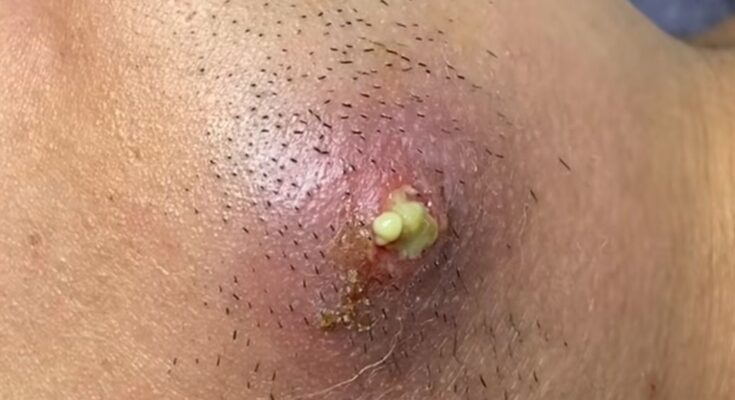🔴 Cystic Acne
These are deep, painful, red lumps under the skin (not black or white on the surface).
✅ Best Treatments:
| Type | What to Use | Notes |
|---|---|---|
| Topical Retinoids | Adapalene (Differin) | Promotes skin turnover, prevents clogging. Use nightly. |
| Benzoyl Peroxide | 2.5–5% gel or wash | Kills acne-causing bacteria. Combine with retinoid. |
| Oral Antibiotics | Doxycycline, Minocycline | Prescription only. Use short-term (8–12 weeks). |
| Isotretinoin (Accutane) | For severe, resistant acne | Very effective but needs medical supervision. |
| Cortisone Injection | Dermatologist-only | Instantly flattens a large cyst. Good for urgent care. |
📌 Do NOT squeeze or pop cystic acne — it causes deeper inflammation and long-term scars.
⚫ Large Blackheads (Open Comedones)
These are clogged pores filled with oxidized oil and dead skin.
✅ Best Treatments:
| Method | What to Use | Notes |
|---|---|---|
| Salicylic Acid | 0.5–2% cleanser or serum | Exfoliates inside the pore. Daily use recommended. |
| Retinoids | Adapalene, Tretinoin | Keeps pores unclogged long-term. |
| Professional Extraction | By esthetician or dermatologist | Safe removal of big blackheads. Never pick at home. |
| Clay or Charcoal Masks | Weekly | Absorb excess oil and clean pores. |
| Pore Strips | Not recommended for deep blackheads | Only work on surface-level plugs and may irritate skin. |
⚠️ What to Avoid
-
DIY popping or squeezing (causes scarring/infection)
-
Toothpaste, lemon juice, or other harsh home remedies
-
Skipping moisturizer — oily skin still needs hydration!
🧴 Sample Routine (for both types)
| Step | Product Type | Example |
|---|---|---|
| Cleanser | Gentle w/ Salicylic Acid | CeraVe SA Cleanser |
| Treatment | Adapalene gel (nightly) | Differin Gel |
| Moisturizer | Oil-free, non-comedogenic | Neutrogena Hydro Boost |
| Sunscreen | Broad spectrum SPF 30+ | La Roche-Posay Anthelios |
🔴 Managing Large Cystic Acne
Cystic acne presents as deep, painful nodules beneath the skin’s surface, often leading to scarring if not properly managed. Effective treatment strategies include:
1. Topical Retinoids
-
Mechanism: Retinoids normalize skin cell turnover, preventing clogged pores.
-
Examples: Adapalene (Differin), Tretinoin.
-
Usage: Apply a pea-sized amount to affected areas nightly.
-
Note: May cause initial irritation; start with a lower concentration and gradually increase.
2. Benzoyl Peroxide
-
Mechanism: Reduces acne-causing bacteria and inflammation.
-
Usage: Apply 2.5–5% gel or wash once or twice daily.
-
Note: Can be drying; use a moisturizer to prevent excessive dryness.
3. Oral Antibiotics
-
Examples: Doxycycline, Minocycline.
-
Indication: For moderate to severe inflammatory acne.
-
Duration: Typically used short-term (8–12 weeks).
-
Note: Combine with topical treatments to reduce antibiotic resistance.
4. Isotretinoin (Accutane)
-
Indication: For severe, recalcitrant acne or acne causing significant distress.
-
Dosage: 0.25–0.5 mg/kg daily, aiming for a cumulative dose of 120–150 mg/kg.
-
Monitoring: Requires regular liver function and lipid panel tests.
-
Note: Strict pregnancy prevention is necessary due to teratogenicity.
5. Corticosteroid Injections
-
Indication: Rapid reduction of large, painful cysts.
-
Procedure: Administered by a dermatologist.
-
Note: Provides quick relief and can prevent scarring.
⚫ Treating Large Blackheads (Open Comedones)
Blackheads are clogged pores filled with oxidized oil and dead skin cells. Treatment approaches include:
1. Salicylic Acid
-
Mechanism: Penetrates pores to exfoliate and reduce oil buildup.
-
Usage: Use a 0.5–2% cleanser or serum daily.
-
Note: May take 6–8 weeks to show results.
2. Topical Retinoids
-
Mechanism: Promotes skin cell turnover and prevents pore blockages.
-
Usage: Apply a pea-sized amount to affected areas nightly.
-
Note: Can be drying; use a moisturizer to prevent excessive dryness.
3. Clay or Charcoal Masks
-
Mechanism: Absorb excess oil and impurities from the skin.
-
Usage: Apply once or twice a week.
-
Note: Avoid overuse to prevent skin dryness.
4. Professional Treatments
-
Options: Comedone extraction, microdermabrasion, chemical peels, laser therapy.
-
Indication: When home treatments are ineffective.
-
Note: Performed by trained dermatologists or estheticians.
5. Avoid Squeezing
-
Risk: Can worsen inflammation and cause scarring.
-
Recommendation: Use appropriate treatments and consult a dermatologist if necessary.
🧼 General Skincare Tips
-
Cleanser: Use a gentle, non-comedogenic cleanser twice daily.
-
Moisturizer: Apply an oil-free, non-comedogenic moisturizer to maintain skin hydration.
-
Sunscreen: Use a broad-spectrum SPF 30+ sunscreen daily to prevent hyperpigmentation.
-
Avoid Touching Face: Minimize touching your face to reduce the transfer of oils and bacteria.
